6 Hauntingly Beautiful Customs and Traditional Festivals Around the World
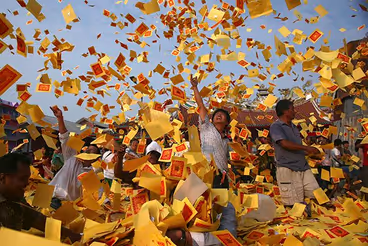
Step into a world where time-honoured traditions illuminate the human spirit, where vibrant cultures paint stories with colours unseen and melodies unheard. Welcome to a journey that promises to unveil the exquisite tapestry of customs and festivals from around the globe, where the sheer uniqueness of each celebration beckons us to leave our comfort zones and experience their beauty firsthand.
It's easy to get lost in the hustle and bustle of our daily lives, but every now and then, we're offered a chance to be part of something greater, something that transcends the ordinary and reveals the extraordinary depths of human creativity and expression. Imagine standing amidst a sea of lanterns, feeling the warmth of camaraderie and the cool breeze of anticipation, as the world holds its breath for a moment of shared wonder. Or picture yourself immersed in the whirl of vibrant dances, each step a testament to a culture's resilience and passion.
The beauty of these customs and traditions lies not only in their external grandeur but in their power to unite generations, forging connections that span centuries. These are more than just spectacles; they're invitations to step into the shoes of another, to understand the unique perspectives that shape our world.
What sets these celebrations apart is their captivating diversity. Each culture, each community, has its own way of expressing joy, grief, and every shade of human emotion in between. It's a reminder that, despite our differences, we share a common thread of humanity that's woven into the fabric of these traditions.
In an era where the world feels more connected yet strangely distant, there's something awe-inspiring about witnessing the magic of these customs firsthand. The way they blend ancient wisdom with contemporary life, the way they harmonize the past and the present in a symphony of colours, sounds, and rituals, is nothing short of remarkable.
So, let this journey be an inspiration, an invitation to explore the world through the eyes of others, to partake in the beauty of their traditions, and to embrace the notion that, in experiencing the unfamiliar, we expand our understanding of what it means to be human. Whether it's joining in the rhythm of traditional dance, sharing a meal that tells stories of generations past, or simply standing in awe beneath a sky ablaze with lanterns, these are moments that enrich our lives in ways words struggle to capture.
As you read on, let yourself be carried away by the magic of these celebrations. And who knows? Perhaps, after immersing yourself in their stories, you'll feel the whisper of curiosity nudging you to experience the enchantment in person, at least once in your lifetime. Because in doing so, you're not just an observer; you become part of a story that's been unfolding for centuries, a participant in the grand tapestry of human existence.
Join us as we embark on a journey to explore 10 of the most enchanting and hauntingly beautiful customs and festivals around the world.
Hemis Festival, Ladakh: Unveiling the Spiritual Grandeur of the Himalayas
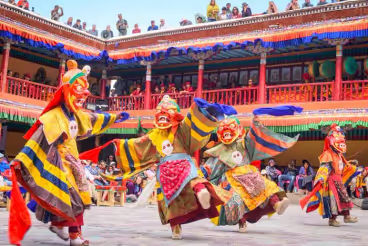
Nestled amidst the lofty peaks of the Himalayas, the Hemis Festival stands as a mesmerizing testament to Ladakh's rich cultural heritage and spiritual resonance. Celebrated with fervour and devotion, this annual extravaganza pays homage to Guru Padmasambhava, the revered Buddhist master who introduced Tantric Buddhism to the region. With masked dances, ancient rituals, and a profound sense of community, the Hemis Festival emerges as an unforgettable experience that beckons travellers to immerse themselves in the heart of Ladakhi tradition.
A Glimpse into Hemis Festival's History and Significance
Every year, the Hemis Monastery, the largest and most iconic Buddhist monastery in Ladakh, comes alive with vibrant colours, rhythmic dances, and an atmosphere charged with spiritual energy. The festival commemorates Guru Padmasambhava's birth anniversary, the 10th day of the fifth month in the Tibetan lunar calendar. Known as "Guru Rinpoche," Padmasambhava is credited with spreading Buddhism across the Himalayan region.
The Dance of Deities: Masked Dances that Tell Tales
At the heart of the Hemis Festival are the captivating masked dances, known as "Cham" dances. These performances are a visual feast, where monks don elaborate costumes and vivid masks, embodying various deities and historical figures. The dances are intricate and graceful, a symphony of movements that echo ancient stories of battles between good and evil, and victories of the righteous over malevolent spirits. Each step, each twirl, is a testament to the dedication and precision of the performers.
The Spiritual Connection and Cultural Unity
The festival isn't just a spectacle for tourists; it's a deeply spiritual event for the Ladakhi people. It's a time when the community comes together to celebrate their heritage, express their devotion, and strengthen their bonds. Amidst the breathtaking scenery of the Himalayan landscape, the Hemis Festival serves as a reminder of the unbroken thread that ties generations past and present.
When to Attend the Hemis Festival
The Hemis Festival takes place on the 10th day of the fifth month in the Tibetan lunar calendar, usually falling in June or July. This timing makes it an ideal opportunity for travellers who want to experience Ladakh's vibrant culture during the summer months when the region is accessible and the weather is relatively pleasant.
Embrace the Magic: Experience Hemis Festival in Person
As you read about the Hemis Festival, the allure of Ladakh's vibrant culture and spiritual significance comes alive. But reading about it is just the tip of the iceberg. The true magic of the festival lies in being there, amidst the beating drums, swirling dances, and the palpable sense of devotion. Imagine standing in the midst of the celebrations, enveloped by the energy of the place and the warmth of the Ladakhi people.
So, why not add the Hemis Festival to your travel bucket list? Experience the enchantment of this ancient tradition, witness the beauty of the Himalayas, and immerse yourself in a culture that remains steadfast amidst the winds of change. The Hemis Festival isn't just a festival; it's a transformative experience that will stay with you long after you've left the mountains behind. It's a chance to witness history, culture, and spirituality intertwine in a breathtaking dance of tradition.
Photo Credit: Travel Triangle
Inti Raymi Festival: A Reverent Journey to the Heart of the Andes
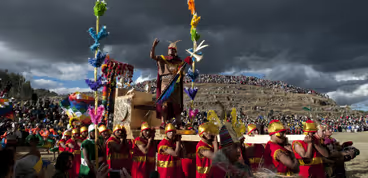
Nestled amidst the majestic peaks of the Andes, the Inti Raymi Festival paints a mesmerizing portrait of Peru's cultural tapestry. A celebration that bridges the gap between modernity and ancient traditions, Inti Raymi pays homage to the Sun God, Inti, in a vibrant display of elaborate ceremonies and vivid processions. This captivating event not only commemorates the past but also unites contemporary Peru with its glorious Inca heritage.
A Glimpse into Inti Raymi's Historical Significance
Steeped in history, Inti Raymi was once the most important festival in the Inca Empire, serving as a tribute to the Sun God, Inti. The festival marked the winter solstice, a time of reverence for the sun's life-giving energy and a celebration of the upcoming agricultural season. After years of suppression under Spanish rule, Inti Raymi was resurrected in the 20th century as a way to honour Peru's indigenous roots and reconnect with its glorious past.
Elaborate Ceremonies and Colorful Processions
At the heart of Inti Raymi lies a series of meticulously choreographed ceremonies that take place at various historical sites within Cusco, the ancient Inca capital. The grand finale unfolds at the historic fortress of Sacsayhuamán, where the Inca Emperor once conducted rituals to ensure a bountiful harvest. Elaborate costumes, traditional music, and intricate dances come together in a harmonious symphony, allowing participants and spectators alike to step back in time and experience the spirit of the Inca civilization.
Uniting the Past and Present
Inti Raymi is more than just a reenactment; it's a living testament to the enduring spirit of Peru's indigenous heritage. In a fusion of old and new, the festival invites locals and visitors to witness a piece of history, immerse themselves in the echoes of an ancient empire, and to reflect on the cultural resilience that continues to shape the nation.
When to Witness Inti Raymi's Splendor
Inti Raymi is celebrated on June 24th each year, coinciding with the winter solstice in the Southern Hemisphere. The date holds deep significance, as it aligns with the time when the sun is at its farthest point from Earth, marking the beginning of the Inca New Year. Travellers looking to partake in this captivating event should plan their visit to Cusco accordingly.
Embrace the Timeless Beauty: Attend Inti Raymi Festival
As you read about the Inti Raymi Festival, the allure of Peru's cultural heritage and spiritual connection comes alive. But don't let it remain on the pages; let it guide you to a breathtaking experience that transcends time. Imagine being amidst the exuberant processions, feeling the rhythm of ancient drums, and witnessing the convergence of past and present.
Why not seize the opportunity to witness this profound event? The Inti Raymi Festival offers not only a chance to celebrate an ancient civilization but also to be a part of something greater – to stand on the soil that once bore the footsteps of the Inca and to share in the collective reverence for the sun's life-giving energy. It's an invitation to celebrate, learn, and be swept up in the vibrant current of Peru's cultural legacy. Don't miss the chance to experience the magic of Inti Raymi at least once in your lifetime.
Dia de los Muertos: Celebrating Life and Death in Vibrant Harmony in Mexico
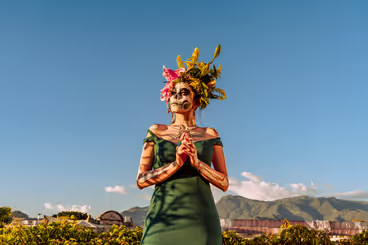
In the heart of Mexico, amidst a tapestry of colours and emotions, lies the captivating tradition of Dia de los Muertos, or Day of the Dead. Far from a sombre occasion, this vibrant Mexican festival is a celebration of life and joyful remembrance of departed loved ones. Ornate altars, marigold petals, and lively processions paint a scene where death and life intertwine, creating a hauntingly beautiful spectacle that invites visitors to embrace the profound cycle of existence.
A Glimpse into Dia de los Muertos' Heartfelt Significance
Dia de los Muertos isn't just a festival; it's a deeply rooted belief that death is not an end but a continuation of life's journey. With its origins tracing back to indigenous Aztec customs, the festival fuses pre-Hispanic traditions with Catholic influences, creating a unique blend of spirituality and culture.
Altars of Love and Remembrance
At the heart of the celebration are ofrendas, ornate altars adorned with photographs, favourite foods, cherished mementoes, and the iconic marigold petals. These altars are carefully prepared to welcome the spirits of departed loved ones back into the realm of the living. Far from morbid, these altars are a testament to the enduring connection between the living and the deceased.
Processions of Joyful Remembrance
Dia de los Muertos culminates in lively parades, where vibrant costumes, traditional music, and spirited dancing infuse the streets with energy. Families and friends come together to honor their ancestors, sharing stories, laughter, and the belief that, for a brief moment, the boundaries between the worlds are blurred.
When to Immerse Yourself in Dia de los Muertos
Dia de los Muertos is celebrated from October 31st to November 2nd, aligning with the Catholic All Saints' Day and All Souls' Day. The most elaborate celebrations can be experienced in various cities and towns across Mexico, with Mexico City, Oaxaca, and Mixquic being some of the most famous venues.
Embrace the Spirit of Dia de los Muertos
As you read about Dia de los Muertos, the beauty of Mexico's cultural tapestry comes alive. Yet, this celebration isn't meant to be merely read about—it's meant to be experienced. Imagine strolling through the vibrant streets, witnessing the artistry of ofrendas, and dancing to the rhythms of life and death.
Don't let this opportunity pass you by. Consider adding Dia de los Muertos to your travel plans. Experience the power of a tradition that doesn't shy away from death but rather embraces it as an integral part of existence. Feel the warmth of the Mexican spirit, taste the delicious pan de muerto, and be part of a celebration that invites you to honour your own past and future. Dia de los Muertos is a breathtaking journey that connects us to the very essence of humanity's shared journey – a once-in-a-lifetime experience that you'll treasure forever.
Yi Peng Lantern Festival: Illuminating the Night Sky with Dreams and Wishes in Chiang Mai, Thailand
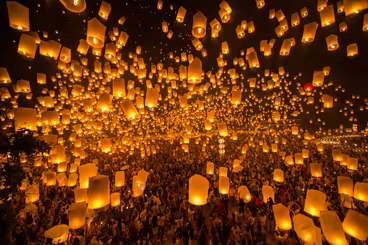
In the heart of Chiang Mai, Thailand, a breathtaking spectacle unfolds as thousands of paper lanterns illuminate the night sky during the Yi Peng Lantern Festival. Against the backdrop of lush landscapes and starlit heavens, this enchanting event symbolizes the release of worries and the embrace of new beginnings. As lanterns rise, hopes to soar, creating a scene of profound beauty that beckons travellers to immerse themselves in the magic of the moment.
A Glimpse into Yi Peng Lantern Festival's Significance
Yi Peng, which translates to "Second Month" in the Thai lunar calendar, holds deep spiritual and cultural significance. The festival, rooted in Buddhist traditions, celebrates the cleansing of past mistakes and the renewal of intentions, all under the gentle glow of countless lanterns.
A Sky Aglow with Dreams and Wishes
As dusk descends, the atmosphere shifts and the scene transforms into a breathtaking display of light and unity. Participants gather with intricately crafted paper lanterns, each inscribed with wishes, prayers, and aspirations. As the lanterns are released into the night sky, a collective sense of hope fills the air, carrying away worries and doubts.
Unity Amidst Diversity
The Yi Peng Lantern Festival is more than a visual spectacle; it's an embodiment of community and unity. Locals and visitors alike come together, transcending language barriers and cultural differences, as they share in the awe-inspiring experience of seeing the night sky aglow with lanterns of all sizes, colours, and hopes.
When to Witness the Sky Aglow
The exact dates of the Yi Peng Lantern Festival vary each year as they follow the Thai lunar calendar. However, the festival usually takes place in November. Chiang Mai is the focal point of the festivities, with various events and ceremonies occurring throughout the city during this period.
Embrace the Ethereal Beauty: Attend the Yi Peng Lantern Festival
As you read about the Yi Peng Lantern Festival, the allure of Chiang Mai's cultural celebration comes alive. Yet, reading is just the beginning. Imagine being surrounded by fellow dreamers, each lantern representing a unique aspiration. Picture the sight of lanterns ascending into the night, carrying with them the hopes of countless souls.
Why not be a part of this ethereal event? The Yi Peng Lantern Festival isn't just a festival; it's a transformative experience that invites you to release your worries, embrace your dreams, and share in the collective optimism that fills the night air. It's a moment of connection, reflection, and of joy that stays with you long after the lanterns have faded from view.
So, consider making a date with the skies, with the stars, and with your own dreams. Experience the Yi Peng Lantern Festival in person, and let your wishes take flight, joining the myriad lanterns that light up the night in a symphony of hope. This is more than a travel destination; it's a journey into the heart and soul of Thailand's vibrant culture, a breathtaking event that promises to leave an indelible mark on your memory and your spirit.
Tsechu Festival: Bridging the Gap Between Earth and Sky in Bhutan
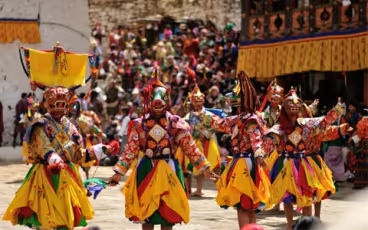
Nestled amidst the breathtaking splendour of the Bhutanese mountains, the Tsechu Festival emerges as a captivating tribute to Bhutan's spiritual legacy. Against the backdrop of majestic landscapes, the festival's intricate dances unfold, weaving together age-old tales that resonate through time. This extraordinary event unites communities in a shared reverence for their cultural and spiritual heritage, inviting travellers to immerse themselves in the captivating traditions of the Land of the Thunder Dragon.
A Glimpse into Tsechu Festival's Profound Significance
The Tsechu Festival derives its name from "Tsechu," meaning "tenth day," in the Bhutanese lunar calendar. Celebrated on the tenth day of various months across Bhutan, the festival commemorates the deeds of Guru Padmasambhava, also known as Guru Rinpoche, who introduced Buddhism to the region.
Dances that Echo Through Time
At the heart of the Tsechu Festival are the intricate masked dances, each telling a story that spans generations. These dances are more than performances; they're a living repository of Bhutan's cultural and spiritual heritage. With vibrant costumes and elaborate masks, the dancers embody deities, historical figures, and legendary beings, captivating spectators and imparting lessons that transcend words.
A Cultural and Spiritual Unity
The Tsechu Festival is a true reflection of Bhutan's essence—a blend of spirituality, culture, and community. As families, friends, and travellers gather to witness the dances, they partake in an age-old tradition that forges connections across generations and backgrounds. It's a moment when the boundaries between the earthly realm and the spiritual domain blur, fostering a sense of unity that reaches beyond borders.
When to Witness the Enchantment
The Tsechu Festival is celebrated across various districts of Bhutan throughout the year, with different regions holding their festivals at different times. The most famous of these festivals, the Paro Tsechu, is usually held in the spring, typically falling in March or April. Travellers interested in experiencing the Tsechu Festival should plan their visit to Bhutan accordingly.
Embrace the Mystique: Attend the Tsechu Festival
As you read about the Tsechu Festival, Bhutan's timeless allure comes alive. But to merely read is to miss out on a once-in-a-lifetime opportunity. Imagine standing amidst the grandeur of the Himalayas, surrounded by the vibrant energy of the dances, and feeling the weight of centuries-old traditions reverberate through the air.
Why not become part of this profound experience? The Tsechu Festival isn't just an event; it's an invitation to step into a world where spirituality and culture intertwine, where stories are told not just through words but through the graceful movements of dancers and the vivid colours of their attire. It's a chance to witness the enchantment that has captivated Bhutan for generations.
So, consider adding the Tsechu Festival to your bucket list. Experience the magic of Bhutan's spiritual celebration in person, and let the stories of the dances take you on a journey through time. It's a once-in-a-lifetime opportunity to be a part of something larger than yourself, to witness a culture's heritage unfold before your eyes, and to carry the echoes of the dances with you, forever etched in your memory and heart.
Obon Festival: A Serene Tribute to Ancestors in Japan
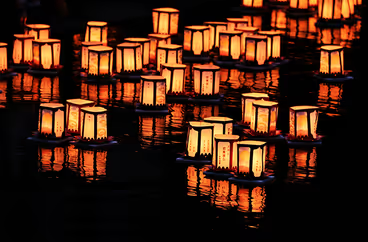
Amidst the tranquil landscapes of Japan, the Obon Festival emerges as a serene and deeply meaningful commemoration of ancestors' spirits. With the soft glow of floating lanterns, graceful dances, and a palpable sense of unity with the departed, this enchanting event blends serenity and reflection in a way that invites both locals and travellers to embrace the sacred bond between the living and the dead.
A Glimpse into Obon Festival's Spiritual Essence
Obon Festival, rooted in the Buddhist tradition, is a time when the Japanese honour their ancestors and pay tribute to their spirits. Believed to be a period when ancestral spirits return to the world of the living, Obon is marked by acts of devotion, unity, and remembrance.
Floating Lanterns and Illuminated Paths
One of the most captivating aspects of the Obon Festival is the release of delicate lanterns onto rivers and lakes. These lanterns, known as "Toro Nagashi," symbolize guiding the spirits back to the afterlife. As the lanterns gracefully float on the water's surface, the scene becomes a dance of light and shadow—a visual embodiment of the ethereal connection between worlds.
Dances that Transcend Time
Obon Festival also features traditional dances known as "bon odori." These dances are performed in a circular formation, reflecting the cyclical nature of life and death. With graceful movements and vibrant attire, participants not only honour their ancestors but also celebrate the unity of the past, present, and future.
When to Immerse Yourself in Serenity
The Obon Festival is observed in different parts of Japan on varying dates, typically falling between July and August. Regions, towns, and even neighbourhoods hold their own versions of the festival, each with unique customs and rituals. If you're planning to experience the Obon Festival, research the specific dates for the area you plan to visit.
Embrace the Tranquility: Attend the Obon Festival
As you read about the Obon Festival, Japan's deep spiritual connection comes alive. Yet, this isn't an event that can be fully grasped through words alone. Imagine the sight of lanterns gently floating on water, carrying with them messages to departed loved ones. Picture yourself joining the circle of dancers, participating in a tradition that transcends time.
Why not make the journey to experience the Obon Festival firsthand? It's not just an event; it's an invitation to connect with a culture's profound reverence for ancestors, to witness the peaceful intermingling of past and present, and to feel a sense of unity with those who have gone before us.
Consider adding the Obon Festival to your travel plans. It's an opportunity to experience the serenity and spiritual depth that have shaped Japan's cultural identity. Let the lanterns guide your way, let the dances captivate your heart, and let the unity with departed souls remind you of the interconnectedness of all life. The Obon Festival is a moment of quiet reflection, unity, and paying homage to the eternal bond that transcends the boundaries of time and space. Don't miss the chance to be part of this deeply moving event, and to carry its beauty with you long after you've left Japan's shores.
Conclusion
As we traverse across mountains, valleys, and cities, the world's customs and festivals reveal themselves as windows to the depth of human culture and history. These age-old traditions are not mere events; they are living testaments that illuminate the soul of a culture, its resilience, and its beautifully haunting echoes of the past. By embracing these customs, travellers embark on a journey that offers profound insights into the diversity and complexity of our world.
Each celebration, from the sacred dances of Bhutan's Tsechu Festival to the vibrant lanterns of Thailand's Yi Peng Festival, tells a unique story. These narratives are pathways to understanding the heartbeats of cultures, their values, and the threads that have woven them into the fabric of time. By partaking in these rituals, we transcend our role as mere observers and become participants in a grander human narrative.
Amidst the colours, dances, and chants of these celebrations, we are reminded that the threads of history connect us to the past, shaping our present and guiding our future. The customs that have endured through generations carry within them the whispers of those who celebrated them before us. These whispers, embedded in the rituals, remind us that we are part of an unbroken lineage of humanity.
In the tapestry of these customs and festivals, we find connection, unity, and purpose. These traditions challenge us to expand our horizons, honour diversity, and carry forward the legacies that have shaped our world. The beauty of these celebrations lies not just in their aesthetics, but in their ability to touch our souls, invite us to remember, and inspire us to create lasting connections with others.
So, let us embark on this journey of cultural exploration with open hearts and open minds. Let us embrace the customs and festivals that have withstood the test of time, allowing them to enrich our understanding of the world's varied tapestry. As we witness these celebrations, let us be reminded of the threads that weave through every moment, connecting us to the past and shaping our future. In embracing these age-old traditions, we celebrate not only the beauty of cultures but also our shared humanity.
 Nandini Sharma
Nandini Sharma